Wives of Henry VIII
In common parlance, the wives of Henry VIII were the six queens consort wedded to Henry between 1509 and his death in 1547. In legal terms, King Henry VIII of England had only three wives, because three of his marriages were annulled by the Church of England. However, he was never granted an annulment by the Pope, as he desired, for Catherine of Aragon, his first wife. Annulments declare that a true marriage never took place, unlike a divorce, in which a married couple end their union.[1] Along with his six wives, Henry took several mistresses.[2][3]
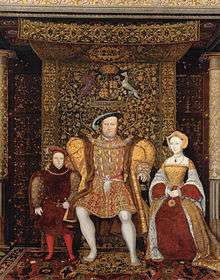
Overview
English historian and House of Tudor expert David Starkey describes Henry VIII as a husband:
What is extraordinary is that Henry was usually a very good husband. And he liked women -- that's why he married so many of them! He was very tender to them, we know that he addressed them as "sweetheart." He was a good lover, he was very generous: the wives were given huge settlements of land and jewels -- they were loaded with jewels. He was immensely considerate when they were pregnant. But, once he had fallen out of love... he just cut them off. He just withdrew. He abandoned them. They didn't even know he'd left them.[4]
The six women who were married to Henry VIII, in chronological order:
| No. | Name | Marriage dates and length | Fate of marriage | Issue and fate |
|---|---|---|---|---|
| 1 | Catherine of Aragon | 11 June 1509 – 23 May 1533 (23 years, 11 months and 12 days) | Annulled | Died 7 January 1536. Mother of Queen Mary I. |
| 2 | Anne Boleyn | 25 January 1533 – 17 May 1536 (2 years, 11 months and 19 days) | Annulled (2 days prior to execution) | Beheaded 19 May 1536 at the Tower of London. Mother of Queen Elizabeth I.[5] |
| 3 | Jane Seymour | 30 May 1536 – 24 October 1537 (1 year, 4 months and 24 days) | Ended with Seymour's death | Died 24 October 1537, due to complications twelve days after giving birth. Mother of King Edward VI. |
| 4 | Anne of Cleves | 6 January 1540 – 9 July 1540 (6 months and 3 days) | Annulled | Died 16 July 1557. |
| 5 | Catherine Howard | 28 July 1540 – 23 November 1541 (1 year, 3 months and 26 days) | Ended with Howard's arrest and later beheading | Beheaded 13 February 1542 at the Tower of London. |
| 6 | Catherine Parr | 12 July 1543 – 28 January 1547 (3 years, 6 months and 16 days) | Ended with Henry's death | Survived Henry VIII, remarried to Thomas Seymour. Died 5 September 1548.[6] |
Henry's first marriage lasted nearly 24 years, while the following five lasted less than 10 years combined.
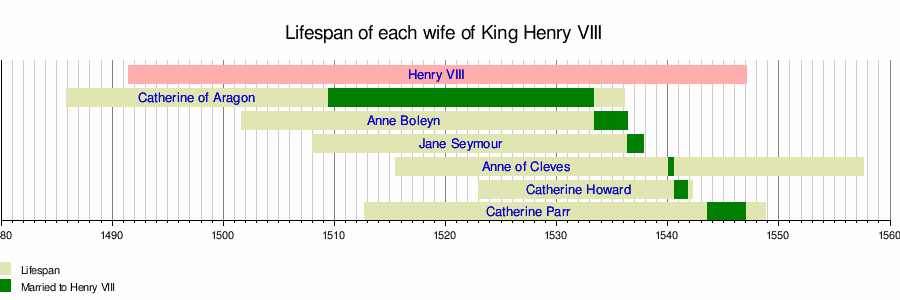
A mnemonic device to remember the names of Henry's consorts is “Arrogant Boys Seem Clever, Howard Particularly”; a mnemonic for their fates is "Divorced, beheaded, died; annulled, beheaded, survived". There are also two rhymes:
King Henry VIII,
To six wives he was wedded.
One died, one survived,
Two divorced, two beheaded.
and
Boleyn and Howard lost their heads,
Anne of Cleves he would not bed,
Jane Seymour gave him a son – but died before the week was done,
Aragon he did Divorce,
Which just left Catherine Parr, of course!
Though technically, the first rhyme should be "Annulled, annulled, died; annulled, beheaded, survived" as his marriage to Anne Boleyn was annulled before her beheading.
It is often noted that Catherine Parr survived Henry, but Anne of Cleves also survived him and was the last of his queens to die (although her marriage to Henry has already been annulled). Catherine of Aragon, Anne Boleyn, and Jane Seymour each gave him one child who survived infancy: two daughters and one son. All three of these children eventually ascended to the throne as King Edward VI, Queen Mary I, and Queen Elizabeth I.
Catherine Howard and Anne Boleyn were first cousins and were both beheaded. Several of Henry's wives worked in service to another wife, typically as a lady-in-waiting. Anne Boleyn served Catherine of Aragon, Jane Seymour served both Catherine of Aragon and Anne Boleyn, and Catherine Howard served Anne of Cleves.
Catherine of Aragon
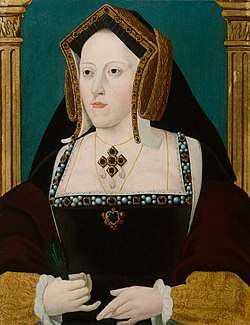
Catherine of Aragon (16 December 1485 – 7 January 1536; Spanish: Catalina de Aragón) was Henry's first wife.[7][8] In modern sources her name is most commonly spelled Catherine, although she spelled and signed her name with a "K," which was an accepted spelling in England at the time.[9] After the death in 1502 of Arthur, her first husband and Henry's brother, a papal dispensation was obtained to enable her to marry Henry, though the marriage did not take place until he came to the throne in 1509. Catherine became pregnant in 1510 but the girl was stillborn. She became pregnant again in 1511, and gave birth to Henry, Duke of Cornwall, who died almost two months later. She gave birth to a stillborn boy in 1513, and to another boy who died within hours in 1515. Finally she bore a healthy daughter, Mary, in 1516. It was two years before she conceived again, the pregnancy ended with a short-lived girl. It is said that Henry truly loved Catherine of Aragon, as he himself professed it many times.
Henry, at the time a Roman Catholic, sought the Pope's approval for an annulment on the grounds that Catherine had first been his brother's wife. He used a passage from the Old Testament (Leviticus Chapter 20 Verse 21): "If a man shall take his brother’s wife, it is an impurity; he hath uncovered his brother’s nakedness; they shall be childless.” Henry had begun an affair with Anne Boleyn, who refused to become his mistress. (He had already ended an affair with Anne's sister, Mary Boleyn.) Despite the pope's refusal to annul the marriage Henry separated from Catherine in 1531. He ordered the highest church official in England, Thomas Cranmer, Archbishop of Canterbury, to convene a court. On 23 May 1533,[8] Cranmer ruled the marriage to Catherine null and void. On 28 May 1533, he pronounced the King legally married to Anne (with whom Henry had already secretly exchanged wedding vows). This led to England breaking from the Roman Catholic Church and the establishment of the Church of England.
William Shakespeare, in the play Henry VIII, called Catherine "The queen of earthly queens" (2.4.138).
Anne Boleyn

Anne Boleyn (1501 – 19 May 1536) was Henry's second wife and the mother of Elizabeth I. Henry's marriage to Anne and her execution made her a key figure in the political and religious upheaval at the start of the English Reformation. She was the daughter of Sir Thomas Boleyn and Lady Elizabeth Boleyn (born Lady Elizabeth Howard), and she was of nobler birth than Jane Seymour, Henry's later wife. She was dark-haired with beautiful features and lively manners; she was educated in Europe, largely as a lady-in-waiting to Queen Claude of France.
Anne resisted the king's attempts to seduce her, and refused to become his mistress as her sister Mary Boleyn had been. It soon became the one absorbing object of the King's desires to secure a divorce from his wife Catherine of Aragon so that he could marry Anne. He wrote a love letter that provides evidence of some level of intimacy between them, in which he admires her "pretty duckies" (breasts).[10] It eventually became clear that Pope Clement VII was unlikely to give the king an annulment, so Henry began to break the power of the Catholic Church in England.
Henry dismissed Thomas Wolsey from public office and later had the Boleyn family's chaplain Thomas Cranmer appointed Archbishop of Canterbury. In 1533, Henry and Anne went through a secret wedding service.[11] She soon became pregnant and there was a second, public wedding service in London on 25 January 1533. On 23 May 1533, Cranmer declared the marriage of Henry and Catherine null and void. Five days later, Cranmer declared the marriage of Henry and Anne to be good and valid. Soon after, the Pope launched sentences of excommunication against the King and the Archbishop. As a result of Anne's marriage to the King, the Church of England was forced to break with Rome and was brought under the king's control.[11] Anne was crowned Queen Consort of England on 1 June 1533, and she gave birth to Henry's second daughter Elizabeth on 7 September. She failed to produce a male heir, her only son being stillborn. Henry grew tired of her and had their marriage annulled. Thomas Cromwell devised a plot to execute her.
Despite unconvincing evidence she was found guilty, and beheaded on 19 May 1536 for adultery, incest, and high treason. After the coronation of her daughter, Elizabeth I, Anne was venerated as a martyr and heroine of the English Reformation, particularly due to the works of John Foxe. Over the centuries, she has inspired or been mentioned in numerous artistic and cultural works.
Jane Seymour
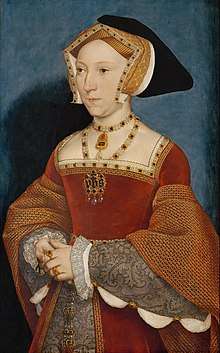
Jane Seymour (c. 1508 – 24 October 1537) was Henry's third wife. She served Catherine of Aragon and was one of Anne Boleyn's ladies-in-waiting.[12] It is believed that she is the mistress who disposed of Anne, who was executed just 11 days before Jane's marriage to the king. The daughter of a knight, she was of lower birth than most of Henry's wives. Almost a year and a half after marriage Jane gave birth to a male heir, Edward, but she died twelve days later from postpartum complications. Henry apparently suffered genuine grief, as she was the only one of his wives to receive a queen's burial. When he died, he was buried next to her.
Anne of Cleves
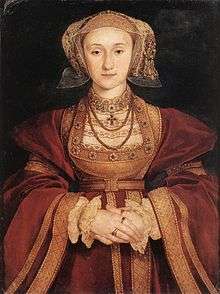
Anne of Cleves (22 September 1515 – 16 July 1557) was a German princess[13] and Henry's wife for just six months in 1540, from 6 January to 9 July. Henry may have referred to her as "A Flanders mare", and the label has stuck.[14] Her pre-contract of marriage with Francis I, Duke of Lorraine, was cited as grounds for annulment. Anne did not resist the annulment, claiming the marriage had not been consummated, and was rewarded with a generous settlement including Hever Castle, the former home of the Boleyns, Henry's former in-laws. She was given the name "The King's Sister", and was a lifelong friend to him and his children. She outlived the King and all his wives.
Catherine Howard
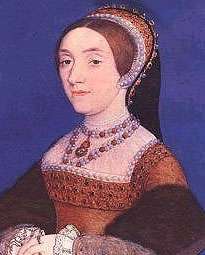
Catherine Howard (c.1521 – 13 February 1542) was Henry's fifth wife between 1540–1542, sometimes known as "the rose without a thorn". She was the daughter of Lord Edmund Howard and Joyce Culpeper, cousin to Anne Boleyn (the second wife of Henry VIII), and niece to Thomas Howard, 3rd Duke of Norfolk. Thomas Howard was a prominent politician at Henry's court, and he secured her a place in the household of Henry's fourth wife, Anne of Cleves, where she caught the King's interest. She married him on 28 July 1540 at Oatlands Palace in Surrey, just 19 days after the annulment of his marriage to Anne. He was 49, and she was still a teenager, at about 17 years old.
Henry was informed of her alleged adultery with Thomas Culpeper, her distant cousin, on 1 November 1541.[15] Catherine was stripped of her title as queen in November 1541. She was beheaded three months later on the grounds of treason for committing adultery.
Catherine Parr

Catherine Parr (1512 – 5 September 1548), also spelled Kateryn, was the sixth and last wife of Henry VIII, 1543–1547. She was the daughter of Sir Thomas Parr of Kendal and his wife Maud Green. Through her father, Catherine was a descendant of John of Gaunt, son of King Edward III. Through John of Gaunt's daughter Joan Beaufort, Countess of Westmoreland (Henry's great-great grandmother), she was Henry's third cousin, once removed. By Henry's paternal descent from another of John of Gaunt's children, John Beaufort, 1st Earl of Somerset, the two were also fourth cousins once removed.[16]
Catherine showed herself to be the restorer of Henry's court as a family home for his children. She was determined to present the royal household as a close-knit one in order to demonstrate strength through unity to Henry's opposition. Perhaps Catherine's most significant achievement was Henry's passing of an act that confirmed both Mary's and Elizabeth's line in succession for the throne, despite the fact that they had both been made illegitimate by divorce or remarriage. Such was Henry's trust in Catherine that he chose her to rule as Regent while he was attending to the war in France and in the unlikely event of the loss of his life, she was to serve as Regent until nine-year-old Edward came of age.
Catherine also has a special place in history as she was the most married queen of England, having had four husbands in all; Henry was her third. She had been widowed twice before marrying Henry. After Henry's death, she married Thomas Seymour, uncle of Edward VI of England, to whom she had formed an attachment prior to her marriage with Henry. She had one child by Seymour, Mary, and died shortly after childbirth. Lady Mary's history is unknown, but she is not believed to have survived childhood.
Ancestry
Henry was distantly related to all six of his wives through their common ancestor, King Edward I of England,[17] through more than one ancestor.[18]
The following family tree of Henry VIII's six wives is the closest lineage of him.
| 1239–1307 Edward I King of England | |||||||||||||||||||||||||||||||||||||||||||||
| 1275-? Margaret Duchess of Brabant | c. 1282–1316 Elizabeth Countess of Hereford | 1284–1327 Edward II King of England | |||||||||||||||||||||||||||||||||||||||||||
| 1300–1355 John III Duke of Brabant | 1312–1360 William 1st Earl of Northampton | 1312–1377 Edward III King of England | |||||||||||||||||||||||||||||||||||||||||||
| 1323–1380 Margaret Countess of Flanders | c. 1350–1385 Elizabeth Countess of Arundel | 1338–1368 Lionel 1st Duke of Clarence | 1340–1399 John 1st Duke of Lancaster | ||||||||||||||||||||||||||||||||||||||||||
| 1350–1405 Margaret III Countess of Flanders[19] | 1366-1425 Elizabeth Duchess of Norfolk | 1355-1382 Philippa 5th Countess of Ulster | 1373–1418 Catherine Queen of Castile | c. 1379–1440 Joan Countess of Westmorland | |||||||||||||||||||||||||||||||||||||||||
| 1371–1419 John Duke of Burgundy | 1388-? Margaret de Mowbray | 1371–1417 Lady Elizabeth Montimer | 1405–1454 John II King of Castile | 1400–1460 Richard 5th Earl of Salisbury | |||||||||||||||||||||||||||||||||||||||||
| 1393–1466 Marie Duchess of Cleves[20] | c. 1425–1485 John 1st Duke of Norfolk | c. 1395–1436 Lady Elizabeth Baroness de Clifford | 1451–1504 Isabella I Queen of Castile | c. 1430-? Alice Baroness FitzHugh of Ravensworth | |||||||||||||||||||||||||||||||||||||||||
| 1419–1481 John I Duke of Cleves | 1443–1524 Thomas 2nd Duke of Norfolk | Mary Clifford[21][22] | Catherine of Aragon 1485–1536 | Elizabeth Lady Parr of Kendal | |||||||||||||||||||||||||||||||||||||||||
| 1458–1521 John II Duke of Cleves | c. 1478–1539 Lord Edmund Howard | c. 1480–1536 Elizabeth Countess of Wiltshire | Henry Wentworth | c. 1483–1517 Sir Thomas Parr | |||||||||||||||||||||||||||||||||||||||||
| 1490-? John III Duke of Cleves[23] | Catherine Howard c. 1523–1542 | Anne Boleyn c. 1501–1536 | c. 1478–1550 Margery Wentworth | Catherine Parr 1512–1548 | |||||||||||||||||||||||||||||||||||||||||
| Anne of Cleves 1515–1557 | Jane Seymour c. 1508–1537 | ||||||||||||||||||||||||||||||||||||||||||||
Armorial bearings
| Coat of Arms | Armiger (Date as Queen) |
Notes | Badges |
|---|---|---|---|
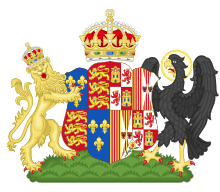 |
Catherine of Aragon 1509 – 1533 |
The Royal Arms, impaled with that of her parents the Catholic Monarchs. The blazon:[24][25]
The sinister supporter came from the coat of arms of her father, Ferdinand II of Aragon, who displayed his shield on the breast of a single-headed Apostolic eagle displayed. Catherine's badges were a commemoration of the conquest of Granada from the Moors, when the superiority of the Spanish archers gained a victory. Both badges were combined with the Tudor rose (Henry's dynastic symbol).[27] |
 |
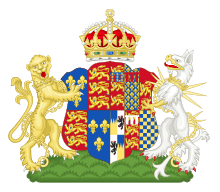 |
Anne Boleyn 1533 – 1536 |
The Royal Arms, impaled with that of her own arms as Marquess of Pembroke, which alluded to several of her ancestors, however remote. The blazon:[24][28]
Badge:[30]
The noted antiquarian and heraldist Charles Boutell commented that the: "Arms of Queen Anne Boleyn are the first which exemplify the usage, introduced by Henry VIII, of granting to his Consorts "Augmentations" to their paternal arms. It is a striking illustration of the degenerate condition of Heraldry under the second Tudor Sovereign."[24] The dexter supporter was intended to represent the leopard of Guyenne (Aquitaine). The sinister supporter was a heraldic creature from the badge of the Boleyn, as descended from Earls of Ormond (Butler).[31] The falcon badge was granted to Anne as Countess of Pembroke, this badge was also used by her daughter Queen Elizabeth I. |
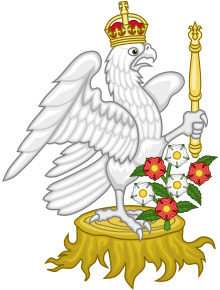 |
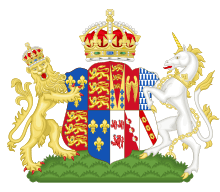 |
Jane Seymour 1536 – 1537 |
The Royal Arms, impaled with that of her own arms and that of the Seymour family. The blazon:[29][32]
Supporters:[29]
Badge:[30]
An alternative set of supporters for Queen Jane was reportedly: "Dexter a unicorn argent, crowned and unguled or, collared with a double wreath of white daisies and red roses; Sinister, a panther incensed, striped with various colours, gorged with a coronet of crosses patée and fleurs de lys alternately and chained or."[32] The badge of the phoenix rising from the flames was granted posthumously by her son King Edward VI to his maternal relations (who became the Dukes of Somerset), who continue to use it as a crest in their coat of arms to this day.[33][34] |
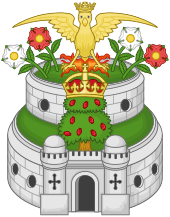 |
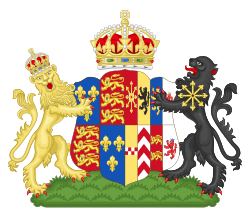 |
Anne of Cleves January – July 1540 |
The Royal Arms, impaled with that of her father John III, Duke of Cleves. The blazon:[35]
Alternatively the arms of Cleves is used only, the blazon:[29]
Badge:[36]
The black lion badge was apparently derived from her mother Maria of Jülich-Berg, who was the sole heir of William IV the Duke of Jülich-Berg.[36] |
|
 |
Catherine Howard 1540 – 1541 |
The Royal Arms, impaled with that of her own as granted by the King. Her arms incorporated those of her family the Howards. Catherine's father Lord Edmund Howard, was the third son of Thomas Howard, 2nd Duke of Norfolk. The blazon:[29][37]
Supporters:
|
|
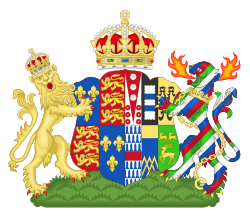 |
Catherine Parr 1543 – 1547 |
The Royal Arms, impaled with that of her own as granted by the King. The arms allude to those of her family and the titles of her father Sir Thomas Parr. The blazon:[29][37][38]
Supporters:[37]
Badge:[30]
The sinister supporter was inherited from her maternal grandfather William FitzHugh, 4th Baron FitzHugh. Her badge was granted by the king, it combined the Tudor rose badge of Henry with a previous one used by the Queen's family. The House of Parr had assumed as a badge "a maiden's head, couped below the breasts, vested in ermine and gold, her hair of the last, and her temples encircled with red and white roses." This they inherited from the badge of Ross, of Kendal.[39] |
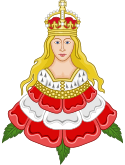 |
In popular culture
Theatrical adaptations
.jpg)
Six is a pop-rock musical featuring each of Henry's wives. A major theme of the show is that women should be the ones to tell their stories and how much more there is to their stories than how their relationships with Henry ended. The musical was written by Toby Marlow and Lucy Moss.[40] It originated in Edinburgh in 2017, moving to the West End in January 2019. In May 2019, Six had its North American premier at the Chicago Shakespeare Theater.[41] and moved to Broadway in March 2020. The tag line of the show, "Divorced. Beheaded. LIVE in concert!", alludes to the rhyme describing the queens' fates.[40]
References
- Goldhill, Olivia (26 January 2016). "Did Henry VIII really have six wives? Why everything you think you know about the Tudors is wrong". The Daily Telegraphy. Retrieved 26 January 2016.
- Hart, Kelly (2009). The Mistresses of Henry VIII. History Press. ISBN 978-0-7524-4835-0.
- Fraser, Antonia (1994). The Wives of Henry VIII. Vintage Books. ISBN 978-0-679-73001-9.
- "The Six Wives of Henry VIII. About the Series. Behind the Scenes | PBS". www.thirteen.org. Retrieved 17 July 2020.
- "Anne Boleyn". tudorhistory.org.
- Hanson, Marilee (31 January 2015). "Katherine Parr --Facts, Information, Biography & Portraits". English History. Retrieved 23 September 2018.
- Erickson, Carolly (2007). Great Harry: A Biography of Henry the VII. St. Martin's Press. p. 48. ISBN 978-0-312-16858-2.
- Lacey Baldwin Smith, Henry VIII: The Mask of Royalty, p. 116
- Davies, C.S.L.; Edwards, John (2011). "Katherine [Catalina, Catherine, Katherine of Aragon] (1485-1536)". Oxford Dictionary of National Biography. England: Oxford University Press. doi:10.1093/ref:odnb/4891.
- "Love Letter of King Henry VIII to Anne Boleyn, 1533". www.luminarium.org.
- "Anne Boleyn 1507–1536." World Book Encyclopedia. "19th ed". 2001. Print.
- Jokinen, Anniina. "The Six Wives of King Henry VII" 2007. Web. 7 May 2009.
- "Anne of Cleves." World Book Encyclopedia. "19th ed". 2001. Print.
- Burnett "History of the Reformation of England" Print
- "Catherine Howard." World Book Encyclopaedia. "19th ed". 2001. Print.
- Lundy, Darryl. "e274.htm". The Peerage.
- Antonia Fraser, The Wives of Henry VIII, genealogical tables
- "English Ancestry of The Six Wives: Descent from Edward I". 22 September 2012.
- Anselme. Histoire généalogique et chronologique de la maison royale de France. 2, p. 741.
- Poupardin 1911, p. 445.
- Richardson I 2011, pp. 507–8.
- Richardson III 2011, p. 236.
- Antonia Fraser. The Wives of Henry VIII (Vintage Books, 1993), Chapter: Anne of Cleves.
- Boutell p. 242
- Pinces & Pinces p. 141
- Aveling p. 307
- Pinces & Pinces p. 142
- Pinces & Pinces p. 144
- Boutell p. 243
- Aveling p. 308
- Willement p. 69
- Pinces & Pinces p. 146
- Willement p. 71
- Fox Davies p. 597
- Pinces & Pinces p. 147
- Willement p. 72
- Pinces & Pinces p. 148
- Boutell p. 244
- Willement p. 75
- http://feastcreative.com, Feast Creative |. "Six the Musical". www.sixthemusical.com. Retrieved 11 June 2019.
- "Chicago Shakespeare Theater: SIX". www.chicagoshakes.com. Retrieved 11 June 2019.
Bibliography
- Aveling, S. T. (1890). Heraldry: Ancient and Modern including Boutell's Heraldry. London: Frederick Warne and Co. ISBN 0548122040.
- Boutell, Charles (1863). A Manual of Heraldry, Historical and Popular. London: Windsor And Newton. ISBN 1146289545.
- Brooke-Little, J.P., FSA (1978) [1950], Boutell's Heraldry (Revised ed.), London: Frederick Warne LTD, ISBN 0-7232-2096-4
- Pinces, John Harvey; Pinces, Rosemary (1974), The Royal Heraldry of England, Heraldry Today, Slough, Buckinghamshire: Hollen Street Press, ISBN 0-900455-25-X
- Willement, Thomas (1821), Regal Heraldry: the Armorial Insignia of the Kings and Queens of England, from Coeval Authorities, London: W. Wilson